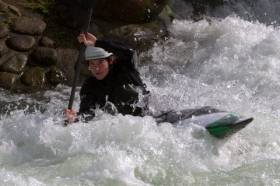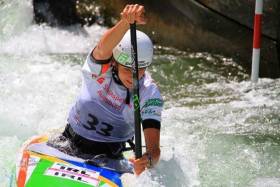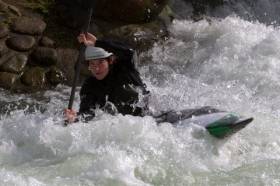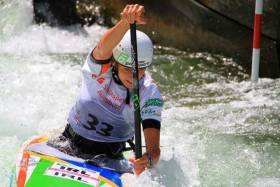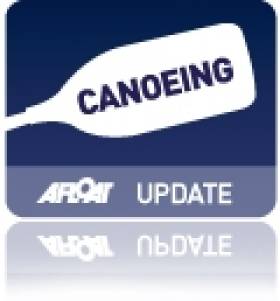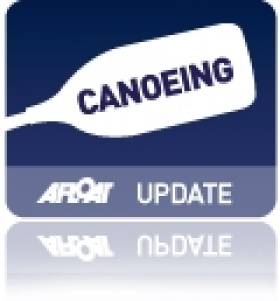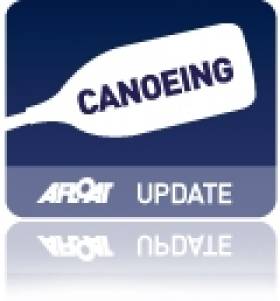Displaying items by tag: Liam Jegou
Jegou Bows Out in European Semi-Finals
#Canoeing: Liam Jegou finished 17th in the under-23 C1 semi-final at the European Junior and Under-23 Championships in Hohenlimburg, Germany today.
The France-based competitor incurred a two-point penalty on the first gate, and while he did not touch or miss another gate his time put him three seconds outside the top 10, who qualified for the final.
Middle Section Costs Jegou in Canoe Slalom World Final
#Canoeing: Ireland's Liam Jegou finished ninth in the Under-23 C1 at the canoe slalom World Championships this morning. The 20-year-old went off second last in the final in Krakow in Poland and set a time of 94.62 seconds. He lost time in the middle section of the course, touching gate 14 and so incurring a two-second penalty. Florian Breuer of Germany had set a time of 87.88 early in the final and it was not matched. He took gold; Lukas Rohan of the Czech Republic silver and Russia's Kirill Setkin bronze.
Canoe Slalom World Championships (Irish interest)
Men
Under-23 C1 Final: 1 Germany (F Breuer) 87.88, 2 Czech Republic (L Rohan) 89.06, 3 Russia (K Setkin) 90.43; 9 Ireland (L Jegou) 94.62.
Superb Performance Puts Jegou Into Canoe Slalom World Finals
#Canoeing: Liam Jegou qualified for the final at the canoe slalom World Championships in Krakow this morning. Going off last of the 20 qualifiers for the semi-final, with a high standard already set, Jegou knew he had to produce a good performance. He put in a superb fault-free run to finish second. His time of 90.48 seconds was just .27 off the top time.
Canoe Slalom World Championships, Under-23 and Junior, Krakow, Poland (Irish interest)
Men
Under-23 C1 Semi-Finals (10 qualify): 2 L Jegou 90.48 seconds.
Jegou Gives Best But Misses Olympic Qualification
#Canoeing: Ireland’s Liam Jegou finished 19th in the semi-finals of the canoe slalom European Championships this morning. Jegou came down the course at Liptovsky Mikulas in Slovakia in 105.02 seconds. He had touches on gates one, nine and 20, thus incurring six seconds on penalties. His time of 111.02 put him fourth at that point – crucially .2 of a second behind Italy’s Raffaello Ivaldi, so ruling out the Irishman taking the top place amongst those countries who had not qualified for the Olympics.
Ander Elosegi of Spain qualified that country for the Olympic Games. He finished sixth in 104.18 – the first boat from a country not already qualified. Elosegi qualified for the final and should Jegou have also qualified, the two would have had to shoot it out on Sunday.
Canoe Slalom European Championships, Liptovsky (Irish interest, selected results) – Day Two
Men
C1 – Semi-Finals: 1 Germany (S Tasiadis) 99.79; 19 Ireland (L Jegou) 111.02 seconds (incl 6 sec pen)
Liam Jegou Qualifies for European Semi-Finals
#Canoeing: Liam Jegou qualified for the semi-finals of the canoe slalom European Championships in Liptovsky Mikulas in Slovakia this morning. A second run of 98.33 seconds with no touches put the 20-year-old through in the C1 category. His first run of 105.36, with a two-second penalty on gate six, had placed him 29th and eight places outside qualification, but his second run was much better. If Jegou can do well enough in the succeeding rounds so that his boat is the first from a country not already qualified for the Olympic Games, he will secure a place in Rio de Janeiro.
Jegou's Penalty-Free Run Not Fast Enough To Secure Olympic Place
#Canoeing: Ireland C1 paddler Liam Jegou finished outside the top 10 nations at the canoe sprint World Championships in Lee Valley in England today and missed out on this chance of qualifying the boat for the Olympic Games. Jegou went off second in his semi-final and had a penalty-free run down the course, but his time of 106.29 seconds was not fast enough to stand in the top 10 nations. Jegou came in 27th, ahead of Italy and Canada. Spain, Portugal and Australia also missed out.
Canoe Slalom World Championships, Lee Valley, London, Day Five (Irish interest)
Men
C1 – Semi-Finals (10 to Final): 27 L Jegou 106.29
K1 – Team Final: 19 Ireland 161.62
Liam Jegou Excels in Second Run to Claim Semi-Final Place at World Championships
#Canoeing: Liam Jegou qualified for the semi-final of the canoe slalom World Championships in Lee Valley, England today. The France-based teenager produced an impressive, penalty-free, second run in the C1 to place ninth, with 10 places available. In his first run, he incurred penalties on gates eight and 11 and had four seconds in penalties, but would have fallen outside qualification in any case. Jake Cochrane placed 68th and 64th in his two runs.
Canoe Slalom World Championships, Lee Valley, London, Day Two (Irish interest)
Men
C1 – First Run (top 20 to semi-finals): 37 L Jegou 95.98 seconds (incl 4 sec pen); J Cochrane 161.15 (incl 54 sec pen). Second Run (10 qualify): 9 Jegou 90.83; 64 Cochrane 108.38 (incl 8 sec pen).
Women
C1 – First Run (top 15 to semi-finals) 32 C O’Ferrall 191.62; Second Run: O’Ferrall 132.14 (incl 4 sec pen)
#CANOEING: Ireland’s Liam Jegou finished fourth in the final of the Canoe Slalom European Junior Championships in Skopje in Macedonia today. The C1 competitor did very well in his semi-final and actually was the fastest man in the final, but the four second penalty for two touche on gates cost him a medal. He will team up with Cade Ryan in a C2 in Sunday’s semi-final, one of two Ireland boats which has qualified.
Canoe Slalom European Junior and Under-23 Championships, Skopje, Macedonia (Selected Results; Irish interest):
Men
Junior - C2 Heats (20 Qualifiers): 15 L Jegou/R Cade 154.64; 16 R Hendrick/N Hendrick 157.39.
C1 Final: 1 Italy 113.18: 4 Jegou 116.99 (4 second penalty for two touches)
Women
Under-23 – K1 Heats (20 qualifiers): 23 A Conlan 129.72 seconds.
Jegou Shoots Into European Canoe Slalom Semi-Finals
#CANOEING: Ireland’s C1 canoeist Liam Jegou qualified comfortably for the semi-finals of he Canoe Slalom European Junior Championships at Skopje in Macedonia today. Jegou, whose mother is Irish and who was brought up in Ireland before moving to France, finished fifth of the 20 qualifiers after the first two runs. There were some problems with the timing at the event.
Canoe Slalom European Junior and Under-23 Championships, Skopje, Macedonia (Selected Results; Irish interest, unofficial)
C1 Junior Heats (top 20 qualify): 5 L Jegou 117.94 seconds; 27 R Hendrick 134.98.
K1 Junior Heats (top 30 qualify): 36 C Ryan 120.71; 40 O Farrell 127.58; 53 N Hendrick 190.69.
Canoeist Liam Jegou Takes World Championship Silver
#CANOEING: Ireland junior canoeist Liam Jegou took a silver medal today at the Canoe Slalom Under-23 and Junior World Championships in Sydney, Australia. On a difficult course in Penrith, only Florian Breuer of Germany was faster in the C1 (canoe single) than the Irishman. Both men took one touch, Jegou’s on the fourth gate. Roman Malyshev of Russia was third and Britain’s Samuel Ibbotson fourth.
“It’s great, I am really happy,” Jegou said. He had come close to a podium finish in the last two years, finishing sixth last year and fourth in 2012.
Canoe Slalom World Under-23 and Junior Championships, Penrith, Sydney (Irish interest):
C1 Men – Semi-Final (10 qualify): 1 Britain (S Ibbotson) 109.47; 6 Ireland (L Jegou) 112.11 (2.64 behind). Final: 1 Germany (F Breuer) 104.31, 2 Ireland (L Jegou) 107.61, 3 Russia (R Malyshev) 108.54.


























